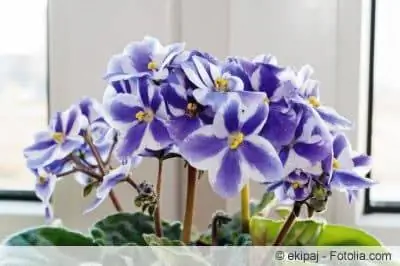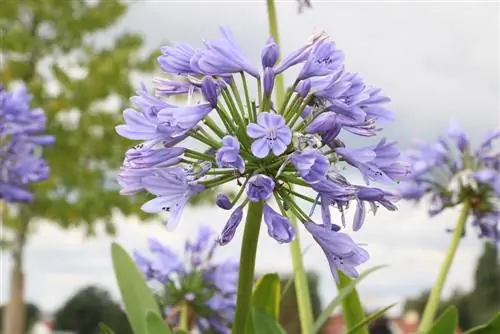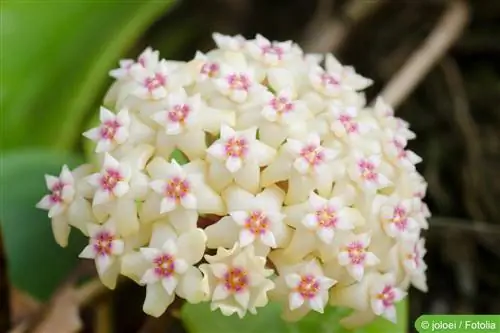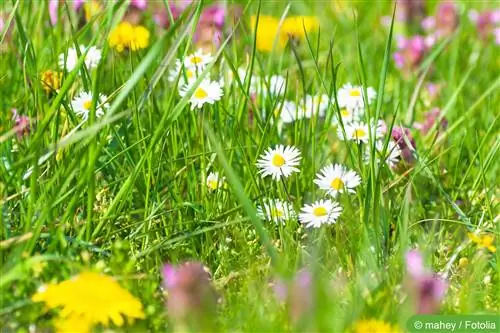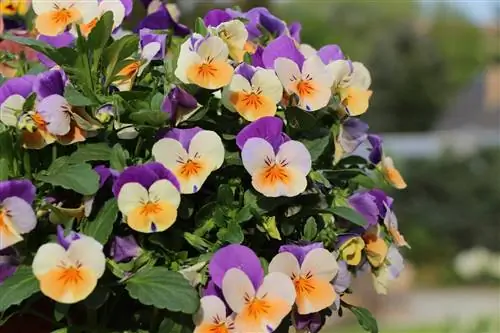- Author admin [email protected].
- Public 2023-12-17 03:39.
- Last modified 2025-01-24 12:45.
The lushly blooming African violet has evolved from a nostalgic potted plant into a floral decorative element in modern room design. Thanks to magnificent flowers from simple to opulent filled in magical colors, the cute gesneria plant harmonizes with every living style. In order for a Saintpaulia to meet creative expectations, sufficient attention should be paid to the somewhat delicate requirements. Find out all the relevant details about professional care and successful propagation here. There are also practical tips on how to make the exotic beauty bloom.
Care
Professional care consists of a carefully tailored package of individual measures, all of which are important. If there are failures in one place, the entire cultivation suffers. Therefore, pay attention to the following measures and the African violet will not let you down.
Location
The following site conditions pave the way to an abundantly blooming Saintpaulia all year round:
- Bright to partially shaded place without blazing midday sun
- A location on the north, west or east window is advantageous
- Comfortable warmth of 20 to 25 degrees Celsius
In addition, the neat potted flower expects tropical humidity of more than 60 percent. To meet this requirement, fill the coaster with pebbles and water. As the moisture evaporates, it permanently coats the flowers and leaves of the African violet. Commercially available humidifiers, an aquarium in the room or a babbling indoor fountain also aim in this direction.
Tip:
Any hope of a richly blooming African violet will come to nothing if the room temperature constantly fluctuates below 18 degrees Celsius. A thermometer placed nearby should then be checked daily.
Pouring
The water balance is one of the main pillars of proper African violet care. In this context, the amount of watering plays just as important a role as the temperature and water quality. How to handle it correctly:
- Saintpaulia water moderately with 18-20 degrees warm water
- If the substrate surface dries, water until the first drops run out of the bottom opening
- Ideally use lime-free rainwater or decalcified tap water
- After 10-15 minutes, pour out the coaster if it is not filled with pebbles

On an African Violet, avoid direct contact of the water with the flowers and leaves. Furthermore, a Saintpaulia does not want to be sprayed with water, otherwise rot could form.
Fertilize
In order to achieve the floral feat of continuous blossoming in unity with evergreen foliage, the lovely potted flower must not lack nutrients. Pamper an African violet every two weeks from March to September with a low-lime liquid fertilizer for flowering plants or an adequate preparation in the form of sticks, cones or granules. If the care plan is based on a winter rest break, stop giving fertilizer from October to February. If a Saintpaulia decorates the winter windowsill with its flowers, apply liquid fertilizer without interruption. Its concentration is diluted by half during the dark season as the exotic plant adapts to the reduced lighting conditions.
Cutting
You can easily remove wilted flowers or unsightly leaves from an African violet with a courageous tug. Avoid using scissors to solve the visual problem. The fleshy nature of an African violet results in rapid rot formation as soon as a tiny remnant of flowers and stems remains on the plant after a cut.
Wintering
There is nothing wrong with cultivating an African violet on the warm windowsill all year round and enjoying the lush abundance of flowers. If, on the other hand, the little beauty is given a winter break, this measure will contribute to a significantly longer lifespan. A Saintpaulia gathers fresh strength in winter under the following conditions:
- Relocate the potted flower in November to a bright, cool room at temperatures around 15 degrees Celsius
- Do not fertilize and water reduced until February
- Continue to take precautions for increased humidity
At the end of February/beginning of March, the winter rest period comes to an end when the flower takes its original position on the warm windowsill and the normal care protocol begins.
Repotting

Regardless of how an African violet spent the winter, the end of February/beginning of March is the ideal time window for moving to fresh substrate and a larger pot. This care measure is only necessary when the container is completely rooted and the first roots grow out of the bottom opening. Choose a new flower pot that is only 2-3 cm larger in diameter, because in the limited substrate volume a Saintpaulia proves to be much more flowery. As a substrate, we recommend a mix of loose potting soil, some rhododendron soil as an acidic component and lava granules or expanded clay. This is how the repotting process goes smoothly:
- A pottery shard above the water drain acts as a drainage against waterlogging
- Fill the lower third with the recommended substrate
- Unpot the African violet and tear off any damaged leaves on the outer edge
- Place in the fresh soil and water while maintaining the previous planting depth
It is important to note that the growing point is below the edge of the pot, while the outer leaves rest on the edge. At the end, press the substrate with a pricking rod or wooden spoon handle until there are no longer any air holes in it that would prevent rooting. A small pouring rim is an advantage so that nothing spills over later.
Tip:
If an African violet is repotted into fresh, pre-fertilized substrate, stop adding fertilizer for the following 4-6 weeks. Until then, the existing nutrient supply covers the requirements and there is no harmful over-fertilization.
Propagate
To successfully propagate an African violet, all you need is a little sensitivity and a steady hand. As practice has shown, breeding is possible using leaf cuttings. To do this, select a vital, he althy leaf and tear it off with the stem. Using a sharp knife or razor blade, cut a narrow strip along the lower edge of the leaf. Now you have the perfect leaf cutting in your hands. Place this 1 cm deep in lean cactus or pricking soil and moisten it with warm, lime-free water. A wooden stick or fireplace match acts as a support. This is how the rest of the process works:
- Place the pot in a partially shaded, warm window spot
- Keep the substrate constantly slightly moist
- A transparent hood encourages rooting
Over the next 5-6 weeks, several daughter plants will grow along the base of the cutting. If such an adventitious shoot has reached a height of 3 cm, cut or tear it off. Water your pupils regularly in a small pot filled with a peat-sand mix, herb or cactus soil. After 3-4 months, the tiny ones transform into strong African violets.
Bring to bloom
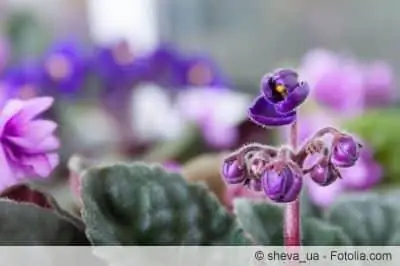
If the African violet refuses to bloom, don't be too quick to throw in the horticultural shotgun. Often there are easily remediable causes that lie behind the dilemma. Put all aspects of care to the test to determine what is bothering the little diva. The following quick overview presents common triggers and possible solutions:
Cause: Unsuitable location
Solution: Relocate
If a Saintpaulia is repeatedly exposed to direct sunlight or is in permanent shade, it will not bloom. The same applies if you expect cool temperatures from the African immigrant. Place the reluctant African violet in a partially shaded location with constant temperatures of 20 to 25 degrees Celsius.
Cause: Dry air
Solution: Increase humidity
Native to the tropical regions of the world, the African violet requires a humidity of more than 60 percent. This requirement is not always met, particularly under the influence of dry heating air. Therefore, place bowls filled with water in the immediate vicinity, a humidifier or line the coaster with pebbles and add water.
Cause: substrate with high lime content
Solution: Repotting in acidic potting soil
In the wild, the African violet thrives in the tropical rainforests of Tanzania. Here the soil is humus, loose and slightly acidic. If you expect the ornamental plant to have a calcareous substrate, you will look in vain for a flower. To get the Saintpaulia to bloom, just pot it in a mix of potting soil, ericaceous or rhododendron soil and lava granules. In addition, in the best case scenario, you only water with collected rainwater or decalcified tap water so that lime does not build up in the plant soil.
Cause: Exhausted
Solution: Winter dormancy
If an African violet has already presented its magnificent flower dress and is now missing it, it simply lacks the strength. Send the exotic diva into winter break in a bright, cool place at 15 degrees Celsius from November to February. During this phase, watering is carried out less frequently and fertilizer is not added at all.
Conclusion
African violets have a reputation for being particularly demanding. In fact, there are just a few aspects that need to be taken into account for successful care. You will choose the exotic houseplant if the location is partially shaded and warm at 20 to 25 degrees Celsius. Moderate watering with lime-free water at room temperature is just as relevant as regular fertilization every 2 weeks from March to September. If you give a Saintpaulia a winter break in a bright location at 15 degrees Celsius, you can enjoy the lush abundance of flowers for many years to come. Propagation is easy with the help of leaf cuttings, so you don't run out of richly blooming window decorations.

